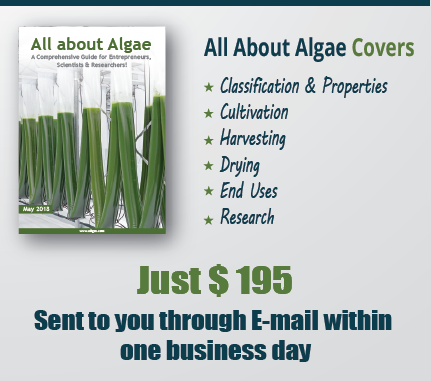Strains used in Algae Waste Water Treatment
Algae may be unicellular or multicellular organism. Algae in wastewater range in size from tiny single cells to branched forms of visible length.
Classes of algae that are commonly found in wastewater treatment plants are:
Green (chlorophyta) - These are freshwater species, can be unicellular or multicellular.
Motile green (euglenophyta) - These are colonial, unicellular and flagellated.
Yellow-green (chrysophyta) - Most forms are unicellular. In this group, the most important are diatoms which have shells composed mainly of silica.
Blue-green (cyanophyta) - These are unicellular, usually enclosed in a sheath and have no flagella. An important characteristic is their ability to use nitrogen in cell synthesis, from the atmosphere as nutrient.
Some of algae strains that can grow well in municipal wastewater are given below.
� Chlorella
� Pithophora sp
� Scenedesmus abundans
� Sargassum muticum
� Spirulina sp
� Botryococcus braunii
� Dunaliella salina
� Ankistrodesmus sp
� Actinastrum sp
� Microactinium sp
� Pediastrum sp
Municipal wastewater is usually treated to get rid of undesirable substances by subjecting the organic matter to biodegradation by microorganisms such as bacteria. The biodegradation involves the degradation of organic matter to smaller molecules (CO2, NH3, PO4 etc.), and requires constant supply of oxygen. The process of supplying oxygen is expensive, tedious, and requires a lot of expertise and manpower. These problems are overcome by growing microalgae in the ponds and tanks where wastewater treatment is carried out. The algae release the O2 while carrying out the photosynthesis which ensures a continuous supply of oxygen for biodegradation. . Algae - based municipal wastewater treatment systems are mainly used for nutrient removal (removal of nitrogen and phosphorous). The added benefit is the resulting biomass that can be used as biofuel feedstock.
Biodegradation of organic waste by algae and bacteria
Nutrients, such as nitrogen and phosphorus, can be removed from wastewater in several ways. The most common way of removing nitrogen is though denitrification leading to reduction of nitrate to nitrogen gas, which is released to the atmosphere (e.g. Metcalf & Eddy et al., 2003). Phosphorus, on the other hand, is often removed by chemical precipitation using FeCl3, etc. However, both phosphorus and nitrogen can be removed by assimilation. This can be accomplished though the growth of bacteria or algae in the wastewater and then the removal of that biomass. The technique of promoting algae growth for nutrient removal was first developed by Oswald et al., (1957).
Microalgae ponds have been utilized for several decades for the treatment of municipal and other wastewaters, with the microalgae mainly providing dissolved oxygen for bacterial decomposition of the organic wastes. Algae and bacteria exist in a classic symbiotic relationship. Bacteria metabolise organic waste for growth and energy, producing new bacterial biomass and releasing carbon-di-oxide and inorganic nutrients. Algae then utilize the CO2 through photosynthesis assimilating the nutrients into algal biomass and releasing O2 concentration, in turn supports the aerobic bacterial activity. Use of Chlorella seems to be one of the feasible methods to reduce the amount of nitrogen and phosphorus entering the nearby coastal water, thus preventing the eutrophication problem which results in depletion of oxygen in water followed by fish death.
The below schematic for an advanced municipal wastewater treatment process uses a multi-stage pond system for complete organic waste degradation and nutrient removal. The initial wastewater treatment ponds are shown, followed by a smaller intermediate "green algae" pond for N depletion, and a final pond for cultivating N-fixing blue-green algae and removing residual phosphates. CO2 supplementation would be required in the last two ponds, and could increase productivity in the initial pond. (Source: Benemann et al. 1978)
Process Schematic for Municipal Wastewater Treatment with Microalgae
| Click Here to Know More | |
| Poly unsaturated fatty acids(DHA,ARA,GAL and EPA) Aquaculture Feed (Shrimp feed, Shellfish Feed, Marine Fish Larve cultivation ) |
|



